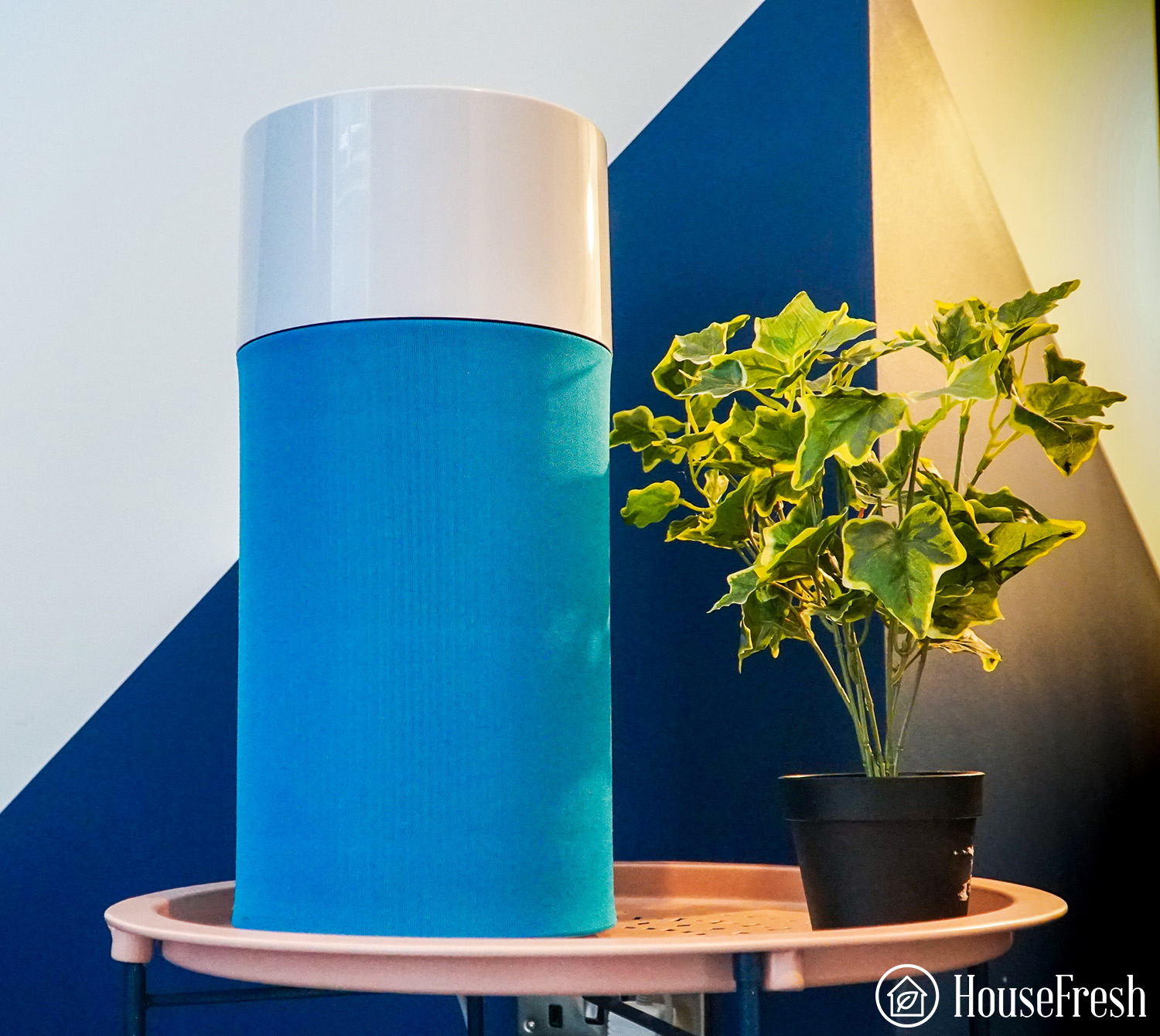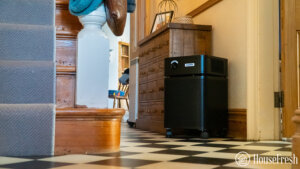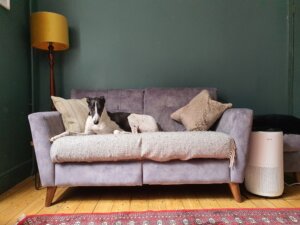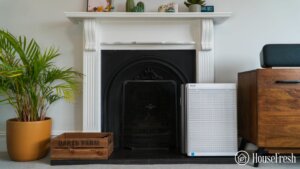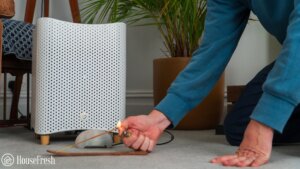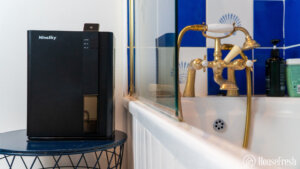Having an air purifier in the home is a great way to reduce pollutants such as dust, bacteria and unwanted odors. Still, the noise of some air purifiers can be off-putting for some. If you have young children or a baby, a loud air purifier can cause significant disruption to their lives — which is the last thing you need.
Mechanical-based air purifiers use HEPA filters that require a fan to work well, which can be problematic regarding noise. Fans, especially those that are older, can make a lot of noise when they are at high speed. Sound levels are just as crucial as air cleaning performance, which is why it’s one of the key things we look for when we review and evaluate air purifiers here at HouseFresh.

We get to test a lot of air purifiers here at HouseFresh, so we also see many loud units. The Molekule Mini hit a high of 88 dB in our tests, which was the highest (and thus, our one to avoid).
But even air purifiers that are great at cleaning the air, like the IQAir Healthpro Plus, can hit 62 dB at the fastest fan speed. The good news is that we also tested a lot of air purifiers that ran quieter than most.
So, read on to discover the quietest air purifiers that don’t compromise on air cleaning.
| Why You Can Trust Our Recommendations These are the most important features we considered when selecting air purifiers that offer solid air cleaning performance yet are quiet: ✔️ High-quality HEPA filter: All the units we recommend primarily use HEPA technology with decades of scientific research supporting it, with no by-products created, such as ozone. ✔️ Activated Charcoal filter: Another filtration technology backed up by science for dealing with gasses and odors ✔️ Sound levels no higher than 52dB: The loudest air purifier we recommend here is 52dB when running at full power, that is equivalent to an electric fan or a hair dryer. ✔️ Good value for your money: We considered costs per CADR and long-term costs (like electricity bills and filter replacements), as there is no point in buying a quiet air purifier if it will cost too much to run. At HouseFresh, we don’t recommend units without being 100% confident in their real-life performance. That’s why we test all the models we recommend in our home lab, following a 3-stage process: STAGE 1 – The first stage is the air cleaning performance test. We use an air quality monitor to track how fast the air purifier can clean incense smoke pollutants from the air when running at full speed inside our 705 cubic ft. test room. STAGE 2 – The second stage is the electricity consumption test. We use an energy monitor to record how much electricity the air purifier needs when running at its top and bottom fan speeds. STAGE 3 – The third stage is the noise levels test. We use a sound level monitor to record noise levels in decibels from the air purifier when running at different speed levels. |
We can compare air purifiers across various use cases with all this data. On top of this, we also track initial costs and long-term costs associated with each unit.
Okay, so, let’s dive right in.
The Best Quiet Air Purifiers in 2023
Now onto the full list!
1. Levoit Core Mini (Noise Level = 25 – 44dB)
The Levoit Core Mini is a perfect little unit for small spaces around your home. This product is a lot smaller than other units and has the lowest noise level at the highest power at just 44 dB, which is the same as a bird call. This well-constructed, premium-built unit is perfect for picking up indoor pollutants and blends perfectly within your home.
Regardless of its size, it still refreshes the air two times per hour in rooms up to 178 square feet and can help remove harmful pollutants such as dust mites, pollen and other indoor contaminants. This product also features an aromatherapy pad near the top of the unit; add essential oils, take in the calming mist and unwind after a long day.
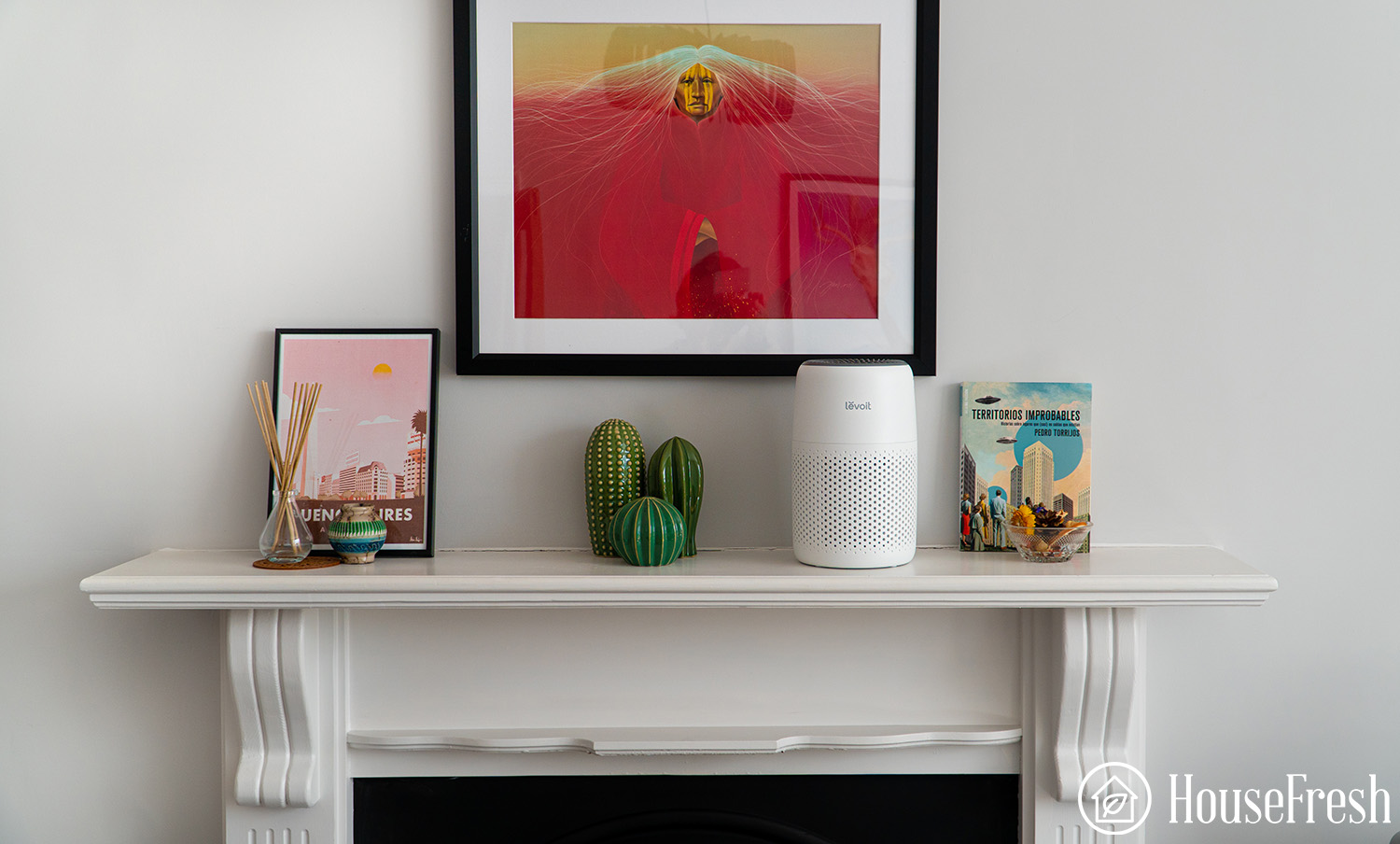
The Core Mini may not pack as much punch as other Levoit units, but some great features give this product unique originality, such as a three-stage filter system. This unit is cleverly crafted with a pre-filter, HEPA filter and an activated carbon filter for odors and VOCs.
What We Really Like:
👍 It is quiet even on the higher settings (44db)
👍 At full power the energy use is quite low as well (7 watts)
👍 The aromatherapy pad is a great addition
👍 Slick design, perfect for kitchens and home offices
What We Think Could Be Better:
👎 The ideal room size is relatively small (178 sq. ft. / 17 m2) — too small for many people
👎 Auto Mode could react faster to air quality changes
Noise Level of the Levoit Core Mini
SPECS & FEATURES
| HouseFresh Rating: | ★★★☆☆ |
|---|---|
| Time to clean our test room: | 1 hour and 53 minutes |
| Air purifier technology: | H13 (Medical) Grade HEPA and Activated Charcoal |
| Recommended room size: | 178 sq. ft. |
| Clean air delivery rate (CADR): | 32 CFM |
| Dimensions (in inches / in cm): | 10.4H x 6.5D x 6.5W inches (26.4H x 16.4D x 16.4W cm) |
| Weight (in pounds / in kg): | 2.2 lbs (1 kg) |
| Noise level (low – high): | 25dB – 44 dB |
| Filter life: | 4 – 6 months |
| Manufacturer’s warranty: | 2 years |
| Estimated energy consumption: | $7.36 per year |
2. Taotronics AP003 (Noise Level = 32 — 52 dB)
We love the Taotronics AP003, and it’s our number one choice for the best budget air purifier this year and bedroom air purifier. It costs less than $70 and includes auto mode and an onboard sensor. The cherry on top is that it hits 226 CFM — usually only available with air purifiers that cost at least $200.
Even at its highest speed, it only hit 52 dB, and due to its ample cleaning power, it can be used at lower speeds to clean a small room like a bedroom quickly. For those looking for a quiet air purifier that can clean as much air as premium-priced models, the Taotronics AP003 is worth a look.
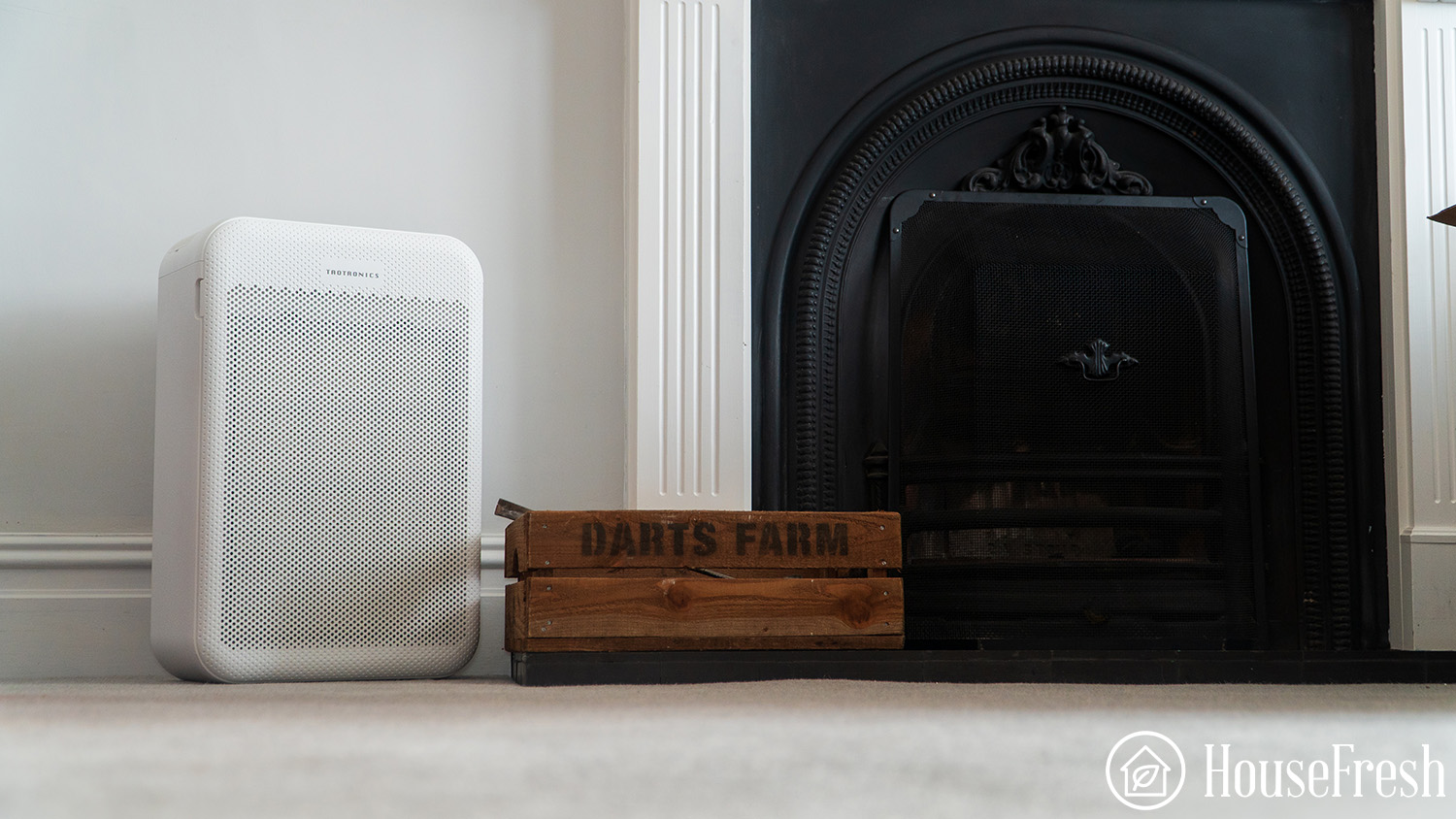
When we tested the Taotronics AP003, it matched the reported CADR scores, as it removed all the pollutants in our test lab in 29 minutes.
What We Really Like:
👍 Great price to CADR score
👍 Fair filter cost replacements in line with budget brands like Levoit
👍 Won’t cost lots in the long term as electricity is low with a maxium draw of 29.6 watts when we tested it
👍 Really love the screen and the fact it shows the exact air quality figure
What We Think Could Be Better:
👎 They are hard to find on Amazon
👎 Still new brand so hard to trust like other brands with many years like Levoit and Alen.
Noise Level of the TaoTronics TT-AP003
SPECS & FEATURES
| HouseFresh Rating: | ★★★★★ |
|---|---|
| Time to clean our test room: | 29 minutes |
| Air purifier technology: | H13 HEPA with activated carbon pellets |
| Recommended room size: | 322 sq ft (30 m²) |
| Clean air delivery rate (CADR): | 226 CFM (384 m³/h ) |
| Dimensions (in inches / in cm): | 21.8 x 14.1 x 7.9 inches (55.4 x 35.8 x 20cm) |
| Weight (in pounds / in kg): | 18 lbs (8.16 kg) |
| Noise level (low – high): | 32 – 52 dB |
| Filter life: | 3 – 6 months |
| Manufacturer’s warranty: | 1 year |
| Estimated energy consumption: | $30.48 per year |
3. Blueair Blue Pure 411+ (Noise Level = 17 — 46 dB)
The Blueair Pure 411 was no stranger in the air quality market; the 411+, however, builds on an already sturdy unit. It’s super easy to move around your home and has some stunning features to help deal with household contaminants. It comes installed with a 3-stage filtration system, including a washable pre-filter, HEPA filter and an activated carbon filter for odors and harmful gasses.
Similar to its predecessor, the 411+ is installed with HEPAsilent technology; this type of HEPA works just the same but produces less noise than other HEPA units. Its noise level on the lowest setting is 17 dB, and on the highest setting, 46 dB, which is as loud as a dishwasher’s hum.
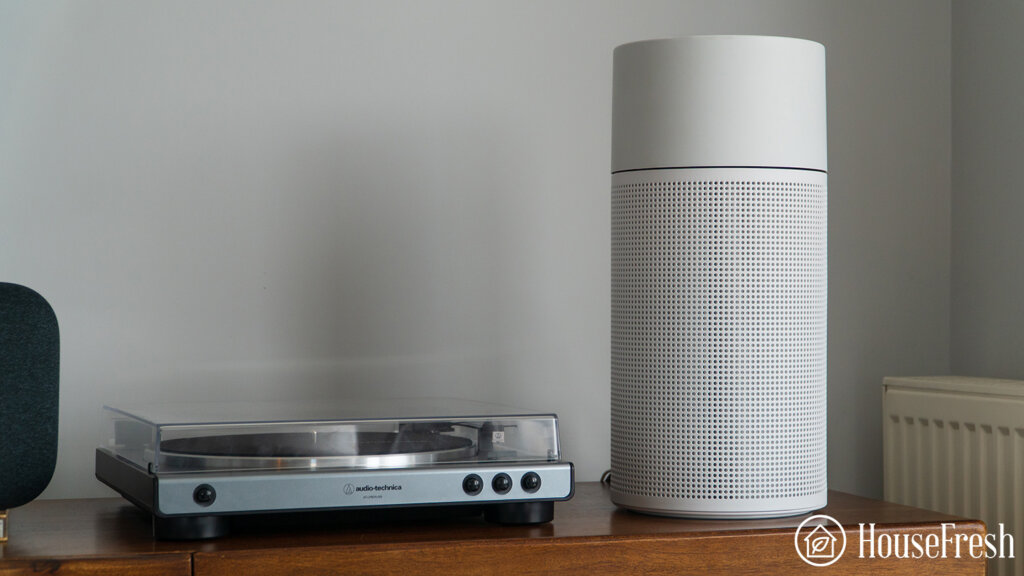
Although the 411+ and the 411 share the same size, noise output, and filter technology, a few new and improved features maximize this unit’s potential. The 411+ has a higher performance efficiency than its original model with an increased Clean Air Delivery Rate (CADR), which extends room size capabilities from 150 sq. ft to around 200 sq. ft. The Blueair Blue Pure 411+ also impresses with a new auto mode, which can determine air quality with just one button push.
What We Really Like:
👍 Its slick, clean and minimalist design blends in well with the house
👍 The pre-filter fabric is unique and comes in different colors
👍 The HEPAsilent technology is super quiet and exclusive to Blueair
👍 Really versatile air purifier – great unit for bedrooms, kitchens, living rooms, and even the garage
What We Think Could Be Better:
👎 We wish the night mode was automatic. LEDs are bright, so you need to change to the low fan setting manually.
👎 The area of coverage is too small
SPECS & FEATURES
| HouseFresh Rating: | ★★★☆☆ |
|---|---|
| Time to clean our test room: | 43 minutes |
| Air purifier technology: | 3-stage True HEPA filter with activated charcoal |
| Recommended room size: | 185 sq. ft. |
| Clean air delivery rate (CADR): | 120 CFM |
| Dimensions (in inches / in cm): | 17H x 7.8W x 7.8D inches (43.18H x 19.812W x 19.812D cm) |
| Weight (in pounds / in kg): | 3.4 lbs (1.54 kg) |
| Noise level (low – high): | 17dB – 46dB |
| Filter life: | 6 months |
| Manufacturer’s warranty: | 1 year |
| Estimated energy consumption: | $10.51 per year |
4. Alen BreatheSmart 75i (Noise Level = 25 — 49 dB)
For a larger unit, the Alen 75i surprises with its low noise output. On the lowest setting, this unit produces just 25 dB and, at the maximum fan speed 49 dB. With a great coverage area of 1300 sq. ft, this cleaner will capture dust, allergens, pollen, fur, pet dander and household odors, PLUS smoke from cigarettes, wildfires and hazardous VOC fumes.
The Alen 75i features a SmartSensor that measures air quality; when placed in auto mode, the fan speed will change whenever necessary. Go about your daily routines and let this great unit do what it does best. The sound generated is also “pink noise” so it supports sleep.
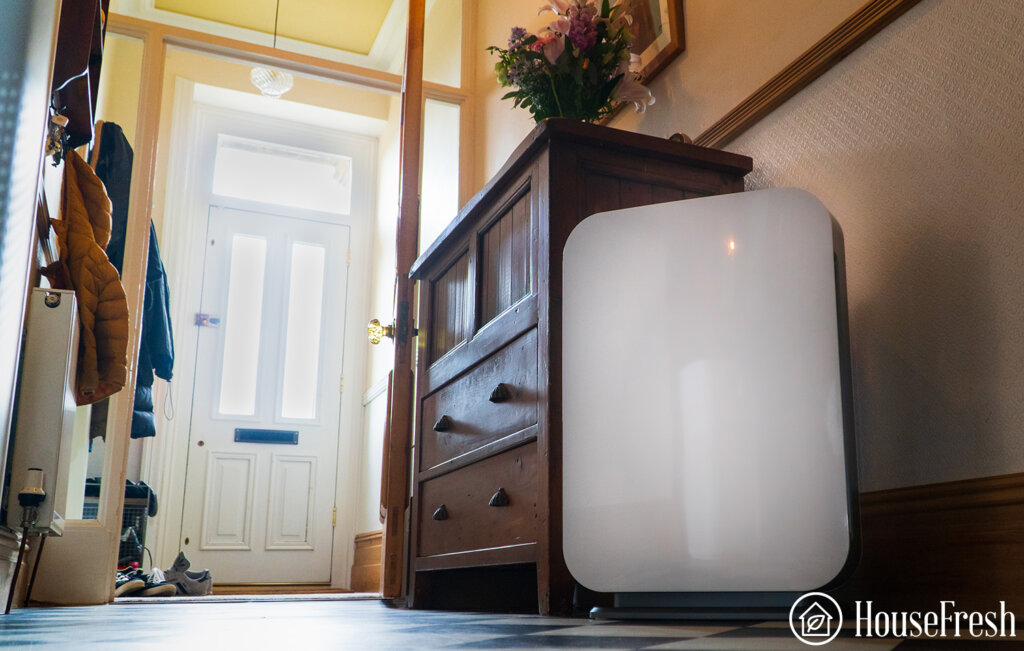
Generally, the best air purifiers on the market come equipped with HEPA and Activated carbon filters which work brilliantly in conjunction with one another. The Alen 75i, however, takes filtration to another level with a True HEPA (H13) filter, known to remove 99.99% of indoor pollutants, leaving only those smaller than 0.1 microns.
In addition to the True HEPA and activated charcoal filters, another surprising feature is the 75i’s Ionizer which enhances particle attraction with the push of a button.
| 💡 Looking for a smaller unit but like the look of the 75i? Consider the Alen BreatheSmart 45i. |
What We Really Like:
👍 Low noise output for a larger unit
👍 The smart sensor measures air quality brilliantly
👍 Filters last a little longer than other units
👍 Has a fantastic coverage area of 1300 sq. ft.
What We Think Could Be Better:
👎 Wish it was a bit smaller as it’s quite a large unit, making it hard to move around all the time
👎 It is on the expensive side of air purifiers
Noise Level of the Alen BreatheSmart 75i
SPECS & FEATURES
| HouseFresh Rating: | ★★★★☆ |
|---|---|
| Time to clean our test room: | 24 minutes |
| Air purifier technology: | True HEPA H13 filters with activated carbon pellets + Ionizer technology |
| Recommended room size: | Up to 1,300 sq. ft. |
| Clean air delivery rate (CADR): | 347 CFM (589 m³/h) |
| Dimensions (in inches / in cm): | 27H x 18.5W x 11.5D inches (68.58H x 46.99W x 29.21D cm) |
| Weight (in pounds / in kg): | 12.2 kg (27 lbs) |
| Noise level (low – high): | 24dB – 49dB |
| Filter life: | 12 – 15 months |
| Warranty: | Lifetime (with product registration & active filter subscription) |
| Estimated energy consumption: | $47.30 per year |
5. Levoit Core 300S (Noise Level = 24 — 48 dB)
The Levoit Core 300S is an innovative and versatile air purifier. It’s compact, yet capable of cleaning the air in a room of roughly 219 sq. ft. This unit is perfect for offices, bedrooms and nurseries as it’s lightweight, meaning it’s easier to move around.
Being an improvement on the Core 300, the Core 300s features a great smart feature that allows you to connect your unit to your phone or tablet and adjust the settings as you see fit. You also get an auto-mode which means that the air purifier will match fan speed to the level of pollutants in the air, potentially saving filter usage and energy usage over the long term. It’s a great feature for those looking for an occasional issue like cigar or weed smoke.

For cleaner air, it has a three-stage filtration system. Stage one is the preliminary filter to take in large particles; this is proven to help increase the HEPA filter life by not putting so much pressure on it. Stage two is the True HEPA filter to capture finer particles such as dust and pollen. Stage three features a high-efficiency activated carbon filter to handle household odors and hazardous VOCs.
This highly energy-efficient unit features a Sleep Mode function that runs the machine at the lowest fan speed to keep the air clean without disturbing your sleep since it operates quieter. It’s known to last longer, too, thanks to the brushless motor that makes it more stable by reducing the chance of overheating.
The timer settings make it even more convenient, so you can set it to run only for two, four, or eight hours. Afterward, it can automatically shut off so that it doesn’t run all day or all night.
What We Really Like:
👍 360° side air intake for purification at all sides
👍 Warm night light with two brightness levels
👍 Top control panel that’s easy to access
👍 Safe design makes it useful for kids’ rooms
What We Think Could Be Better:
👎 Core 3000S is higher priced than we would like for this performance and smart features
👎 You have to replace the filters every six months
Noise Level of the Levoit Core 300S
SPECS & FEATURES
| HouseFresh Rating: | ★★★★★ |
|---|---|
| Time to clean our test room: | 39 Minutes |
| Air purifier technology: | 3-Stage H13 True HEPA Filtration with Activated Carbon |
| Recommended room size: | Up to 219 ft² |
| Clean air delivery rate (CADR): | 141 CFM (240 m³) |
| Dimensions (in inches / in cm): | 8.7L x 8.7W x 14.2H inches (22L x 22W x 36H cm) |
| Weight (in pounds / in kg): | 5.95 lb (2.7 kg) |
| Noise level (low – high): | 24dB – 48dB |
| Filter life: | 6 – 8 months |
| Manufacturer’s warranty | 2 years |
| Estimated energy consumption: | $52.56 |
6. Smart Air S (Noise Level = 23 — 52 dB)
The Smart Air S is one of the best-looking air purifiers we have purchased. But the Air S is not just a pretty face. The results of our testing backed up its CADR score of 185 CFM, showing this unit has the power it takes to clean the air efficiently in a space of up to 430 sq. ft.
We chose the Smart Air S because, on the lowest setting, this air purifier produces just 23 decibels, equivalent to the sound of a natural area with no wind. When you turn this unit to its highest fan speed, the sound level can reach 52 decibels (the noise produced by a refrigerator).

The Smart Air S is equipped with a powerful H11 HEPA filter that can deal with small particles such as dust, pollen and smoke. If you also want to tackle odors or VOCs, you will need to buy an activated charcoal filter as it doesn’t come as standard.
As always, we tested this air purifier by lighting a potent incense stick inside our 705 cubic ft home lab and recording how fast it took the unit to clean the air from airborne pollutants. The Smart Air S managed to remove all the pollutants from the air in 29 minutes, placing the Air S in our top 15 fastest air purifiers we have tested.
What We Really Like:
👍 The size of a laundry basket so that it can be tucked away easily
👍 Modern design that is truly unique to the Smart Air brand
👍 Very powerful unit for its size
👍
What We Think Could Be Better:
👎 It would be great if it came with a timer function
👎 It would be better if it had an auto mode feature for detecting indoor air quality
Noise Level of the Smart Air S
SPECS & FEATURES
| HouseFresh Rating: | ★★★★☆ |
| Time to clean our test room: | 29 minutes |
| Air purifier technology: | H11 HEPA and optional activated charcoal filter |
| Recommended room size: | 430 sq. ft. |
| Clean air delivery rate (CADR): | 185 CFM (315 m³/h) |
| Dimensions (in inches / in cm): | 13H x 13W x 14.3D inches (33.02H x 33.02W x 36.32D cm) |
| Weight (in pounds / in kg): | 10.1 lbs (4.58 kg) |
| Noise level (low – high): | 23dB – 52dB |
| Filter life: | 6 months |
| Warranty | 1 year |
| Estimated energy consumption: | $45.20 per year |
7. Blueair Blue Pure 411 (Noise Level = 17 — 46 dB)
The Blueair Blue Pure 411 non “+” version has unique HEPASilent filtration technology. It utilizes less energy and makes less noise but at a lower cost than the 411+.
For large contaminants, you get a pre-filter that can be washed (rather than replaced) for long-term use. Then the HEPASilent technology uses electrostatic filtration to remove tiny particles. Then, there’s the particle filter to capture airborne germs and the activated carbon layer for odors.
Suppose you don’t like the idea of electrostatic technology. In that case, you will want to avoid this unit, as there is currently no way to disable it. Still, we didn’t see any ozone generation and were impressed with the higher cleaning performance without large noise generation.
On the lowest setting, it’s known as one of the quietest air purifiers, making it ideal for use at night. It’s highly eco-friendly and can run all day without raising energy bills. Also, with a 360° air intake, you can place it in any direction and still receive the same efficiency.
Knowing when to change the filter is simple, thanks to the built-in LED warning system that will glow red. The general LED function will dim after about seven seconds. Although the 411 doesn’t feature an auto mode (like the updated 411+), it still performs excellently and features the all-important HEPAsilent technology. With more features, the price rises, so the 411 is the best choice if you are watching your budget.
What We Really Like:
👍 Can customize using six pre-filter color options
👍 Simple 1-button operation
👍 Small and sleek to remain unobtrusive
👍 Causes a noticeable difference in air quality in a short amount of time
What We Think Could Be Better:
👎 Lacks a timer function
👎 No automatic fan speed adjustment
Noise Level of the Blueair Blue Pure 411
SPECS & FEATURES
| HouseFresh Rating: | ★★★☆☆ |
|---|---|
| Time to clean our test room: | 68 minutes |
| Air purifier technology: | Washable pre-filter, activated carbon filter, HEPASilent™ filter |
| Recommended room size: | 185 sq. ft. |
| Clean air delivery rate (CADR): | 120 CFM |
| Dimensions (in inches / in cm): | 17H x 7.8W x 7.8D inches (43H x 19.8W x 19.8D cm) |
| Weight (in pounds / in kg): | 3.4 lbs (1.5 kg) |
| Noise level (low – high): | 17dB – 46dB |
| Filter life: | 6 months |
| Manufacturer’s warranty: | 1 year |
| Estimated energy consumption: | $10.51 per year |
The Loudest Air Purifier We’ve Ever Tested – One to Avoid: Molekule Air Mini (Noise Level = 39 — 86 dB)
You may have heard of the Molekule Air Mini when it won a design award from Fast Company and made bold claims about its cleaning power in the press. But after some abysmal reviews from Consumer Reports, The Wirecutter and HouseFresh, along with a big complaint from Dyson, those claims have since been retracted.
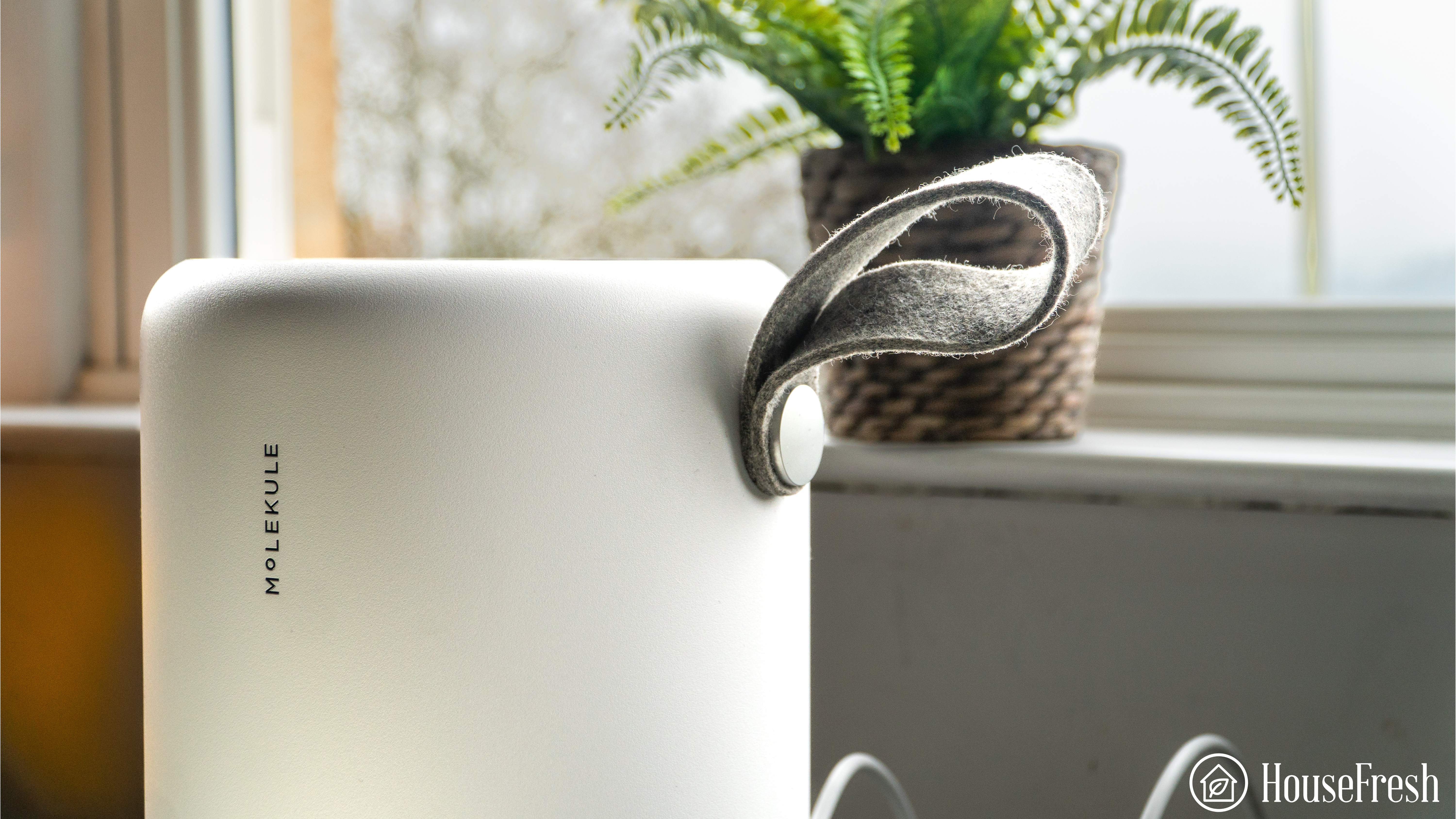
The big problem and the reason we suggest you avoid it is due to how loud it is.
You can see in our video below for yourself but we saw nearly 86 dB, which can cause ear damage for long periods.
The sound alone would be enough to avoid this unit, but it was also nearly useless at removing particulate pollutants in our home test — it was never able to remove all particles, even when left on for many hours.
It’s also not cheap; we paid $599.99!
| Why We Suggest You Avoid This Unit: 👎 Android app doesn’t work for anyone 👎 Very high sound level 86 dB 👎 High initial costs and usage costs such as filters and energy usage |
If you are concerned about a loud air purifier, then be sure to avoid the Molekule Mini.
What You Need to Know Before Buying a Quiet Air Purifier
A loud air purifier can be a bother.
Nobody wants a super loud 80 dB air purifier simply because it can absorb virtually all pollutants in their home. We’re talking about air pollution vs. noise pollution here!
While a good air purifier will improve indoor air quality, this doesn’t need to come at the expense of peace and quiet. So, the first thing you’ll want to consider when buying a quiet air purifier for your home is its decibel (dB) output.
Some air purifiers, like the Molekule Mini, produce more than 80 dB of noise output when running at full speed. While such purifiers might be good at cleaning the air, they can cause significant disruption to your life, particularly if you have a baby or young children.
Research shows that noise harms sleep patterns, with sound volume being the most significant influencing factor. So, if you’re in the market for a new air purifier, consider buying a quiet one. In this guide, you’ll learn how to choose the best quiet air purifier for your home. But first, a quick primer on how sound affects sleep.
| How Sound Affects Sleep In today’s tech-centric world, peace and quiet can be a rarity. The sound of a TV, music playing, your neighbors arguing, and even a buzzing phone can disturb you and affect the quality of your sleep. If you’re wondering why you never fall asleep fast, know that noise is usually most disruptive during your light stages of sleep. Even if the noise at night doesn’t wake you up, it tends to affect the quality of your sleep by changing the time you spend in certain sleep stages. Indoor noise, such as the one from fans (picture loud air purifier), tends to negatively impact stage 1 sleep (light sleep). Some studies have also shown that noise during sleep can increase the production of hormones, such as cortisol and adrenaline, and cause elevated heart rate and blood pressure. Getting sufficient and undisturbed sleep is critical for feeling good and performing well. In one study, the reduction of noise levels and reverberation led to an increase in the quality of deep sleep. |
What to Consider When Buying a Quiet Air Purifier
Given the negative impacts of environmental noise at night, you’ll want to invest in a quiet air purifier that won’t negatively impact your sleep.
Here’s what to consider when buying a quiet air purifier.
1. Consider the overall decibels
The standard air purifier with a high-efficiency particulate air (HEPA) filter will have an overall noise output between 40 dB and 70 dB. At 40 dB, the purifier is quiet enough and provides relatively calm background noise.
However, those with 70 dB and above noise output are very loud and unsuitable for home use.
A purifier’s noise output level will depend on the fan speed settings. When the fan speed is low, there is minimal noise output and vice versa.
| Note: Quiet air purifiers have similar functionalities to regular air purifiers. The only difference is that the quiet air purifiers leverage advanced technology to minimize noise levels. |
2. Check whether it has a Sleep Mode
If a quiet air purifier is a top priority, choose a sleep mode option. This ensures the device is set to the lowest fan speed possible for the least sound output.
3. Check the CADR rating
By checking the air purifier’s clean air delivery rate (CADR) rating, you’ll understand how effectively the device filters pollutants within a given room size.
For example, a device with a 250 CADR rating for pollen will be more effective than one with a 200 CADR rating for the same room size. The 250 rating means the air purifier can produce 250 cubic feet of fresh air per minute to remove pollen from the room.
Therefore, the higher the CADR rating, the faster the air purifier will clean a room’s air.
4. Consider its energy efficiency
As is often the case when buying other household appliances, considering the total energy usage is vital. Power consumption is an important factor since your purifier will continuously consume energy. Depending on the fan speed setting, a higher dB unit will likely consume more power.
The standard purifier will have a power rating of between 17 and 100 watts. You can always use an energy usage calculator to compare different air purifiers by using the cost per kWh, wattage, and usage hours as measurement parameters.
Although a quiet air purifier will produce less noise output than regular models, knowing what to consider when buying one is essential. When buying a quiet air purifier, consider the unit’s dB level, CADR rating, energy efficiency, and whether it has a sleep mode.
Common Questions About Air Purifiers and Sound
🤔 What is the quietest home air purifier?
The quietest air purifier we ever tested was the Sharper Image Ionic Breeze which didn’t use mechanical filtration. It made noise but generated dangerous ozone levels and did little to clean the air of particles, so it’s not a unit I would recommend.
If you are looking for the best quiet air purifier, we recommend the Levoit Core Mini or Taotronics AP003. They run much quieter than similar units with the same level of air-cleaning power. They hit a maximum decibel rate of 44 dB and 52 dB.
🤔 Are all air purifiers noisy?
Generally, air purifiers don’t make much noise, producing a level similar to many familiar household fans. Most people would consider them to release ambient noise, so it may not bother everyone. However, the noise varies depending on the unit’s fan.
Many have multiple fan speeds, and the lowest speeds are the quietest. Also, how loud an air purifier may or may not further depend on the specific model. Many have a Sleep Mode function that allows them to go into whisper-quiet operation, so it’s barely heard. We go in more detail about what air purifiers do in our recently updated blog post.
🤔 What do 20 decibels sound like?
Sound is measured in decibels, also abbreviated as dB. Normal breathing produces around 10 dB. Meanwhile, a washing machine can reach up to 70 dB, and fireworks can reach up to 150 dB.
You don’t want anything over 85 dB or so constantly in your house. Thankfully, many quiet-operating air purifiers are around 20 dB on the lower settings. This places them just above regular breathing.
Bottom Line
Air purifiers can work wonders at making the air in your home cleaner and easier to breathe in. Typical ones can produce the same or slightly higher noise than a typical house fan. Not everyone can or wants to deal with such noise, though.
For instance, if you’re going to run your purifier at night, something quieter can make sleeping easier. Or perhaps you’re in a home with children or babies, and the sound can startle them. That is where a quality and quiet air purifier can come in and help improve your air without dealing with noise.
Thankfully, there are many top-rated quiet air cleaners on the market. Hopefully, our article will find the right one for your home.
Last update on 2024-04-22 / Affiliate links / Images from Amazon Product Advertising API

